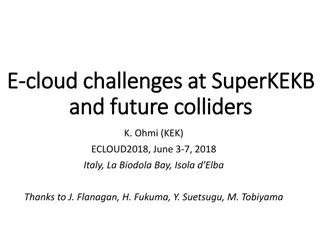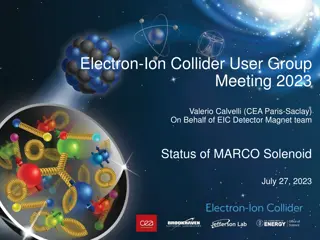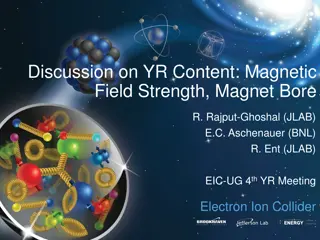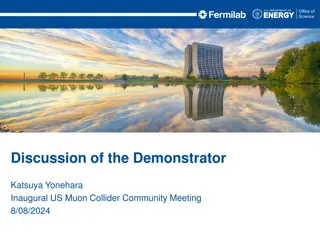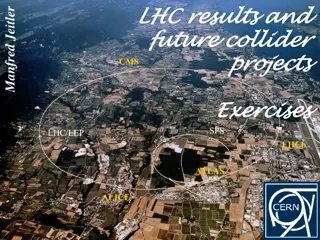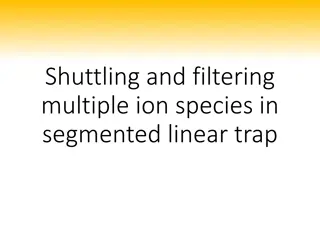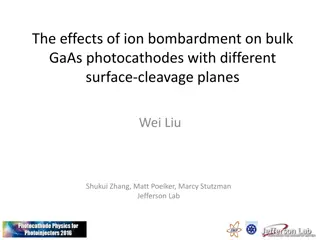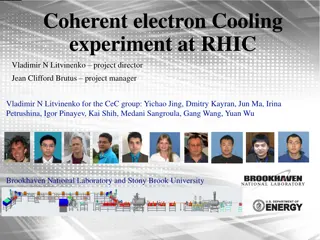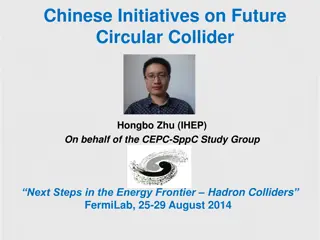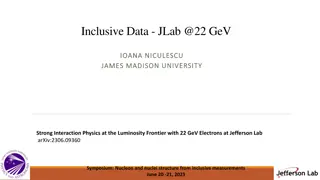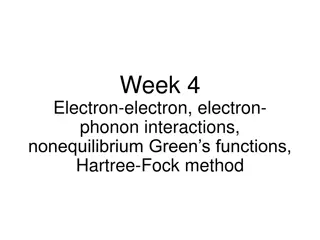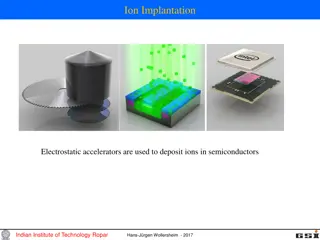Challenges and Upgrades in Electron-Ion Collider Interaction Regions
The article discusses vacuum issues, design challenges, and experiences in the interaction regions of Electron-Ion Colliders. It explores the unique characteristics of the HERA collider, including beam currents, bunch spacing, and straight sections. Additionally, it covers the upgrades and improvements implemented in HERA-II, such as stronger focusing and superconducting magnets for enhanced luminosity.
Download Presentation

Please find below an Image/Link to download the presentation.
The content on the website is provided AS IS for your information and personal use only. It may not be sold, licensed, or shared on other websites without obtaining consent from the author. Download presentation by click this link. If you encounter any issues during the download, it is possible that the publisher has removed the file from their server.
E N D
Presentation Transcript
1 Vacuum Issues in the IR of an Electron-Ion Collider Christoph Montag BNL
2 EIC Interaction Region Design Challenges Very asymmetric beam energies High luminosity requires early beam separation to allow focusing close to the IP Hard, intense synchrotron radiation generated near or even inside the detector must be passed safely through the IR Short electron bunches excite HOMs that lead to gas desorption p-A (proton beam-gas) cross sections typically 100-1000 times larger than e-p Physics cross sections 1 10 10
3 The HERA Experience Only electron-ion collider ever built 920GeV protons, 27.5GeV electrons (or positrons) Comparatively low beam currents, ~100mA protons, ~50mA electrons 180 bunches per ring 96nsec bunch spacing 250m long straight sections for low- focusing, beam separation, and spin rotators
4 HERA-I Interaction Region (ZEUS Detector)
5 Synchrotron Radiation in HERA-I 6kW total SR power, critical energy 34keV Half of SR power absorbed upstream of detector by 3 movable collimators (C1-C3) Two fixed collimators (C4, C5) near IP against back-scattering SR absorbers at 24m/25m downstream of IP Very good background conditions
6 HERA-II The Luminosity Upgrade New interaction regions, with smaller beam cross sections at the IP, achieved by stronger focusing Low- quadrupoles close to the IP for sufficient aperture Beam separation and electron beam focusing by superconducting combined-function magnets inside the detectors Based on novel, exotic IR magnets Factor 3 luminosity improvement over HERA-I
7 HERA-II Interaction Region Superconducting combined-function quadrupoles 1.7m from the IP inside the detector, providing electron beam focusing and beam separation Normal-conducting mirror-plate quadrupoles to focus proton beam and pass electron beam and synchrotron radiation fan
8 ZEUS Detector after the Luminosity Upgrade
9 Synchrotron Radiation Fan in HERA-II 18kW of synchrotron radiation power, with up to 115keV critical energy produced by separator magnets inside the detector No upstream SR collimators; entire radiation fan must pass through the detector Synchrotron radiation absorbers at 11m septum, and at 27m main source of background
10 Vacuum System Vacuum pipes for electrons, protons and SR separate 11m downstream of IP Flat cross section of common stainless steel chamber requires special flanges, and protection by emergency absorbers Lots of pumping installed: NEG strips in all stainless steel chambers Ion getter and Ti sublimation pumps in-between magnets Integrated ion getter pump inside the detector, at 1.3m from the IP Superconducting magnet beam pipes at 40-80K Needed to be warmed up for regeneration of NEG pumps No valves between warm and cold magnets due to space constraints
11 Background Conditions in HERA-II Very severe background conditions after luminosity upgrade, limiting beam currents and therefore luminosity to avoid radiation damage to detectors Extensive background studies leading to modifications during several months of shutdown: Proton beam-gas interactions Larger pumps at critical locations Increased pumping port conductance Improved mask shapes to reduce HOM losses Synchrotron radiation background Added synchrotron radiation collimator far upstream Improved masks in IR Improved magnet alignment, beam steering, and control Electron beam-gas (off-momentum positrons) Additional vacuum pumps 30m upstream
12 IR Vacuum Pressure during HERA-II Luminosity Stores
13 IR Vacuum Evolution Gradual improvement due to beam conditioning, interrupted by a few vacuum failures (leaks)
14 Beam-Gas Background in HERA-II Two time constants for vacuum conditioning: Short term after leaks, 20-30 days Long term, ~2 years
15 RHIC Experience Two superconducting storage rings Energy range 10 100GeV/n Au, 25 250GeV protons 111 bunches/ring, 106nsec bunch spacing All ions other than protons cross transition
16 RHIC bunch intensity evolution Steady bunch intensity increases achieved by: NEG coating of warm beam pipes (2004-2008) Pre-pumping before cool-down (from 2006) Keeping machine at liquid nitrogen temperature over the shutdown Intentional scrubbing at injection, using short, high-intensity bunches Parasitic scrubbing by long physics runs, and no vacuum breaks in-between
17 RHIC Vacuum in STAR Detector After Solenoid Power Supply Failure STAR detector solenoid prevents electron cloud instability in detector beampipe
18 eRHIC High beam currents 330 bunches per ring in initial phase, up to 1320 in final configuration Large crossing angle (22mrad) to avoid dipoles near IP Large electron beam-beam parameter (up to 0.1) requires near-integer tunes for dynamic focusing to compensate emittance blow-up Strong dynamic focusing effects increase beam divergence at the IP, and beam sizes in the low-beta quadrupoles Increased beam size results in more electrons experiencing large magnetic fields in those magnets, increasing synchrotron radiation power and critical energies Dynamic focusing effects have to be taken into account when determining required apertures in IR design
19 Design Concept Based on RHIC with 275GeV polarized protons Electron storage ring with 5 18GeV 1320 bunches per ring Up to 2.7A electron current similar to B-Factories 10MW maximum RF power Very flat normalized proton emittances: 2.4um horizontal, 0.1um vertical achieved by strong hadron cooling Low proton bunch intensities: 0.75*10^11 Full energy polarized electron injector Peak luminosity1.2 1034?? 2??? 1 Initially, 330 bunches and no hadron cooling - 2.6 1033?? 2??? 1
20 In-situ RHIC beam pipe coating Large number of short, intense proton bunches requires in-situ copper coating of stainless steel RHIC beam pipes to reduce resistive wall heat load on cryo system May need additional layer of amorphous carbon to reduce SEY for electron cloud reduction
21 Interaction Region Layout Interleaved arrangement of electron and hadron quadrupoles 22mrad total crossing angle, using crab cavities Beam size in crab cavity region independent of energy crab cavity apertures can be rather small, thus allowing for higher frequency Forward spectrometer (B0) and Roman Pots (R1-R4) for full acceptance
22 IR Detail Actively shielded electron beam pipe through superferric hadron spectrometer B0
23 Synchrotron radiation in eRHIC IR Synchrotron radiation from quadrupoles only; no dipoles due to crossing angle Few electrons in transverse tails experience high magnetic fields
24 SR Power Density outside 1mm Be Pipe Wall Effects on detector background still under study
25 Summary Multiple sources contribute to background conditions in electron-ion collider detectors synchrotron radiation and beam-gas scattering Measures to reduce one source may increase another HOMs from synchrotron radiation masks may lead to thermal desorption of gas molecules, resulting in increased beam- gas background Close interaction between machine and detector during the design process as well as during commissioning and operations is necessary for success





